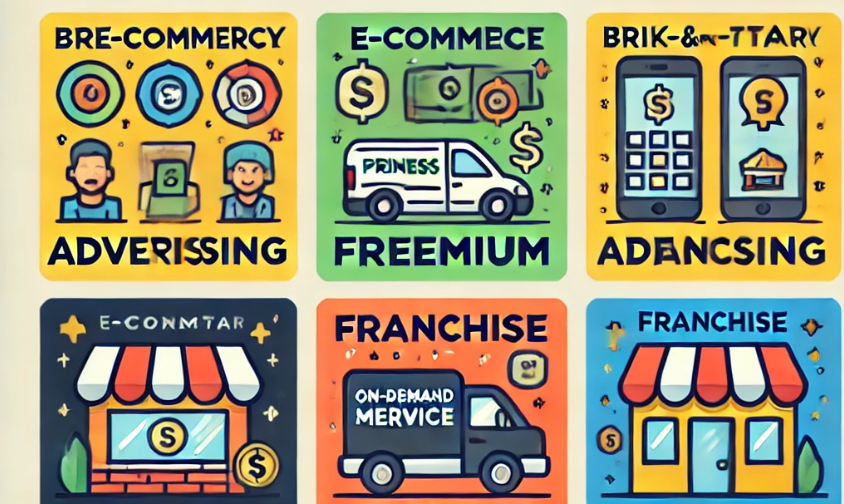In the dynamic world of business, understanding and selecting the right business model is crucial for success. Whether you’re a startup founder, an established business owner looking to pivot, or an investor seeking the next big opportunity, grasping the nuances of various business models can make the difference between thriving and merely surviving in today’s competitive marketplace.
This comprehensive guide will explore traditional and emerging business models, examine the impact of technology on business strategies, and provide actionable insights for choosing and implementing the right model for your venture.
The Foundation: Core Business Model Types

Before diving into cutting-edge strategies, it’s essential to understand the fundamental business models that have stood the test of time:
a) Brick-and-Mortar Retail Despite the rise of e-commerce, physical stores continue to play a significant role in the retail landscape. Businesses like Walmart and Target have successfully adapted this model to the digital age by integrating online and offline experiences.
Pros:
- Direct customer interaction
- Immediate product availability
- Opportunity for experiential marketing
Cons:
- High overhead costs
- Limited geographical reach
- Inventory management challenges
b) Wholesale Wholesalers like Costco have built empires by selling products in bulk to retailers or directly to consumers. This model relies on high-volume sales and efficient supply chain management.
Pros:
- Economies of scale
- Simplified product range
- Strong supplier relationships
Cons:
- Lower profit margins
- Dependence on large orders
- Limited direct consumer engagement
c) Service-Based From consulting firms to hair salons, service-based businesses offer expertise or skills rather than physical products. This model often requires less capital investment but relies heavily on human resources and reputation.
Pros:
- Lower inventory costs
- High potential for customer loyalty
- Flexibility in service offerings
Cons:
- Scaling challenges
- Dependence on skilled workforce
- Difficulty in standardizing quality
d) Subscription The subscription model has gained immense popularity in recent years, with companies like Netflix and Adobe leading the charge. This approach provides a steady revenue stream and encourages long-term customer relationships.
Pros:
- Predictable recurring revenue
- Higher customer lifetime value
- Opportunity for data collection and personalization
Cons:
- Pressure to continually provide value
- Churn management
- Initial customer acquisition costs
e) Freemium Popularized by tech companies like Spotify and Dropbox, the freemium model offers basic services for free while charging for premium features. This approach can rapidly build a user base and create upselling opportunities.
Pros:
- Low barrier to entry for users
- Viral growth potential
- Data collection for product improvement
Cons:
- Balancing free and paid features
- Converting free users to paying customers
- Potential for high server costs
f) Platform Platform businesses like Uber and Airbnb create value by facilitating interactions between two or more groups. This model can lead to rapid scaling and network effects.
Pros:
- Scalability
- Low overhead costs
- Network effects
Cons:
- Chicken-and-egg problem in initial growth
- Regulatory challenges
- Balancing interests of different user groups
g) Marketplace Similar to platforms, marketplaces like Amazon and Etsy connect buyers and sellers but often take a more active role in transactions and fulfillment.
Pros:
- Wide product selection
- Commission-based revenue
- User-generated content and reviews
Cons:
- Quality control challenges
- Competition with sellers
- Building trust and safety measures
Emerging Business Models: The New Frontier
As technology and consumer preferences evolve, new business models continue to emerge. Here are some innovative approaches gaining traction:
- Sharing Economy Companies like Airbnb and Zipcar have revolutionized how we think about ownership and access. This model leverages underutilized assets, creating value through temporary access rather than permanent ownership.
- On-Demand Services The rise of smartphones has fueled the growth of on-demand services like Uber Eats and TaskRabbit, connecting service providers with customers in real time.
- Direct-to-consumer (D2C) Brands like Dollar Shave Club and Warby Parker have cut out middlemen by selling directly to consumers, often through subscription or e-commerce models.
- Circular Economy Companies like Rent the Runway and ThredUp are pioneering sustainable business models focused on reuse, recycling, and reducing waste.
- Decentralized Autonomous Organizations (DAOs) Blockchain technology is enabling new forms of organization, where decision-making and operations are governed by smart contracts and community voting.
The Impact of Technology on Business Models
Technology continues to reshape how businesses create and deliver value. Here are key technological trends influencing business models:
- Artificial Intelligence and Machine Learning AI are enabling personalized customer experiences, predictive analytics, and automation across industries. Companies like Netflix use AI to recommend content, while manufacturers employ machine learning for predictive maintenance.
- Blockchain Beyond cryptocurrencies, blockchain is being used to create transparent supply chains, secure digital identities, and enable new forms of decentralized finance.
- Internet of Things (IoT) Connected devices are creating new service-based business models in industries ranging from healthcare to agriculture. For example, John Deere now offers data-driven farming insights through IoT-enabled equipment.
- 5G and Edge Computing The rollout of 5G networks and advancements in edge computing are enabling real-time data processing and new applications in areas like autonomous vehicles and augmented reality.
Data and Trends: Shaping the Future of Business Models
To stay ahead in the rapidly evolving business landscape, it’s crucial to keep an eye on emerging trends and data. Here are some key areas to watch:
- Personalization at Scale Consumers increasingly expect tailored experiences. Businesses that can leverage data to provide personalized products and services will have a competitive edge.
- Sustainability and Social Responsibility Environmental concerns and social awareness are driving consumer choices. Business models that incorporate sustainability and social impact are gaining traction.
- Remote Work and Digital Nomadism The shift towards remote work is changing how businesses operate and creating new opportunities in areas like co-working spaces and digital collaboration tools.
- Privacy and Data Protection As data becomes more valuable, businesses must navigate complex regulations and consumer expectations around privacy and data usage.
- Ecosystem Thinking Successful companies are increasingly thinking beyond their immediate products or services to create broader ecosystems that provide integrated solutions for customers.
Choosing the Right Business Model
Selecting the appropriate business model is a critical decision that can make or break your venture. Here are key factors to consider:
- Market Analysis Thoroughly research your target market, including customer needs, competition, and industry trends.
- Value Proposition Clearly define the unique value your business offers and how it aligns with customer needs.
- Resource Assessment Evaluate your available resources, including financial capital, human resources, and technological capabilities.
- Scalability Consider how your chosen model can grow and adapt to changing market conditions.
- Revenue Streams Identify potential revenue sources and assess their sustainability and growth potential.
- Competitive Advantage Determine how your business model creates a defensible competitive advantage.
- Regulatory Environment Understand the legal and regulatory landscape that may impact your chosen model.
To assist in this process, consider using tools like the Business Model Canvas or seeking advice from a pitch deck consultancy to refine your strategy and presentation.
Conclusion
The business model landscape is more diverse and dynamic than ever before. Success in today’s market requires not only choosing the right model but also being prepared to adapt and innovate as conditions change. By understanding the range of traditional and emerging business models, staying attuned to technological advancements, and keeping a pulse on market trends, entrepreneurs can position themselves for success in the ever-evolving world of business.
Remember, the most successful companies often combine elements from multiple business models or pioneer entirely new approaches. The key is to remain flexible, customer-focused, and open to innovation. As you navigate your entrepreneurial journey, continually reassess your business model and be prepared to pivot when necessary. In doing so, you’ll be well-equipped to thrive in the exciting and challenging world of modern business.








